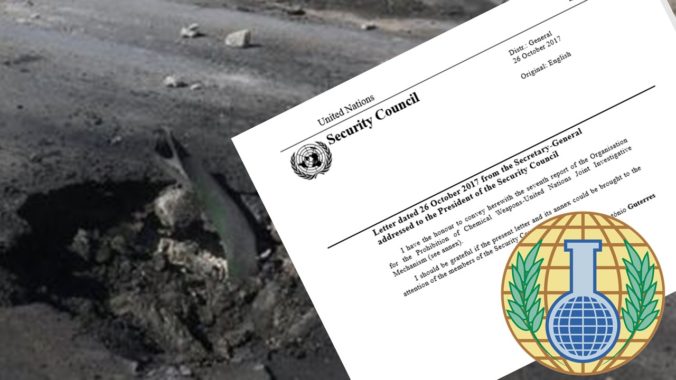The human mind doesn’t deal well with complexity. It seeks shortcuts, often being fooled by one of many cognitive biases. One of the goals at Rootclaim is to reduce uncertainty by breaking down complex questions into more manageable pieces. This whole system is strengthened by the open crowd-sourced approach, which increases the breadth, depth, and creativity of the analysis. A good case in point is the contrast between the recent UN Joint Investigative Mechanism (JIM) report on the Khan Sheikhoun chemical attack, and the Rootclaim analysis of the same incident.
Confidence
The JIM report concludes by stating that it is “confident” that the Syrian government bears responsibility for a sarin attack in Khan Sheikhoun on April 4th. This conclusion is based on evidence that Syrian aircraft flew near Khan Sheikhoun around the time of the chemical attack; that the sarin emanated from a crater created by a high velocity aerial bomb; and that certain chemical markers in sarin samples from the attack match the Syrian Army’s chemical weapons supply.
Missing Hypotheses
The Rootclaim analysis on the other hand, sheds doubt on that confidence. The first glaring issue is with the potential hypotheses used to explain the attack. The JIM report provides detailed arguments based on unnamed expert assessments about what caused the crater and left the kinds of fragments found in Khan Sheikhoun. However, these arguments are primarily focused at rebutting the hypothesis of an improvised explosive devise (IED).
The report creates a false dichotomy: it explicitly states that it only considers an aerial attack or an IED. Since the evidence does not look like an IED, the JIM report concludes that it must have been an aerial attack. The scenario which Rootclaim’s analysis found to be the most likely – a surface-to-surface projectile – is not even considered. In fact, most of the evidence that the report considers to have pointed with confidence to an aerial bomb is just as likely under the projectile option. Such a glaring omission is nearly impossible in an open analysis, and highlights a major disadvantage of investigative committees.
Downplaying Evidence
Another flaw in the report is the relative ease with which it dismisses potential evidence, accepting arguments seemingly without a very critical analysis, or an in-depth examination of the actual likelihoods. For example, the report cites radar data showing that Syrian aircraft were no closer than 5 kilometers of Khan Sheikhoun. An anonymous expert is then quoted as saying that an attack with an aerial bomb from such a range is “possible.” However, the report makes no effort to determine how likely, or unlikely, such a possibility is. A review of literature and aerial attack videos shows that such a flight path would be very unlikely.
Similarly, the report cites multiple hospital records that show that many sarin victims were admitted well before the aircraft took off. These are trivialized as “discrepancies” that the JIM chose not to investigate.
This type of bias, known as “tunnel vision,” occurs when early in the investigation one hypothesis seems more likely, causing investigators to focus resources only on confirmatory evidence. Rootclaim’s methodology avoids “tunnel vision,” since all of the evidence is examined using the exact same process, and the results are open to public scrutiny.
Furthermore, in Rootclaim, everything is assigned a probability backed by statistics and solid reasoning, rather than employing vague statements like “possible” or “confident.” This forces analysts to consider the likelihoods of each occurrence, especially relative to the different hypotheses. In particular, if the sarin came from an aerial attack, reconciling the evidence of planes flying over Khan Sheikhoun at 6:45 AM with evidence of sarin affecting locals well before 6:30 AM requires assuming significant coincidences.
Each of these two discrepancies has the potential to completely flip the conclusion if properly investigated, yet they are dismissed outright. That is a grave flaw in an international investigation that bears serious implications in a conflict affecting millions of lives.
Possible Cherry-Picking
The report includes evidence from chemical analyses, which purportedly shows that the sarin used in the attack bears markers that are common to the chemical weapons held by the Syrian government. Such markers seem to be strong, but not conclusive, proof of who actually used the weapon (the sarin could have been stolen, with the government choosing not to report it, or manufactured by a defector from the government’s chemical weapons program).
However, we’re not actually provided with enough data to know how damning the chemical markers claim is. Information about how often one should expect these markers to be found in chemical weapons would be integral for understanding how much weight to give this evidence.
Moreover, it is unclear what is the population of markers from which the matches are reported. Three chemical markers were similar to the Syrian’ Army’s stockpile. However, there may have been dozens of other markers that did not match. In that case this is exactly what should be expected by chance. Without the full information, it is difficult to determine its strength.
Rootclaim Reaches a Different Conclusion
The UN originally blamed Syria. The JIM report “confidently” corroborated this conclusion. However, an objective analysis of only the raw evidence listed in the report (i.e. crater is a result of a falling object with no explosion, the aircraft wasn’t near the target, poisoning started before the alleged aerial attack, chemical markers match the Syrian stockpile, but only the matches are reported) actually strengthens the hypothesis of a sarin projectile. This and other evidence, when aggregated, leads to a very different conclusion – that the most likely perpetrator of the Khan Sheikhoun attack was an opposition group to the north, using a surface-to-surface sarin projectile.
Even when relying on what is purportedly the pinnacle of human investigation – a UN sanctioned investigative committee – human biases can distort the conclusions. Rootclaim’s open crowd-sourced methodology, its equal incorporation of evidence supporting different hypotheses, and the breakdown of complex arguments into manageable pieces, allows Rootclaim to provide a more accurate and objective view on controversies like Khan Sheikhoun.


November 12, 2017 at 4:20 am
To add on the sarin match: from what I gather, the match is not to materials surrendered by Syria and their known process for making sarin, even in part. *maybe this is the case with JIM, will have to review). Usually, it just matches the sarin used in other attacks – impure, foul-smelling, etc. KS sarin matches Saraqeb sarin, Ghouta sarin matches Khan al-Assal sarin, and they probably all match each other. Since each likely terrorist attack was blamed on Assad, the blame just get stronger with each new matching case.
November 12, 2017 at 4:28 am
From the report: “The Mechanism commissioned an in-depth laboratory study of the origin of the precursor chemical DF used to produce the binary sarin released in Khan Shaykhun. This study revealed that the sarin released in Khan Shaykhun had most
likely been made with the precursor DF from the original stock from the Syrian Arab Republic. An initial screening of reports concerning previous incidents of the release of sarin in the Syrian Arab Republic showed that some “marker chemicals” appear to be present in environmental samples. This would warrant further study. This finding relates only to the origin of the DF used as precursor and not to the
those responsible for the dissemination of sarin.”
I think that supports my reading: based on matches to other attacks Syria denies and terrorists always benefit from, it’s the same stuff and so it’s the same people.
November 13, 2017 at 10:56 am
Thanks for your comment Adam.
Indeed, the JIM report identified Phosphorous Hexafluoride (PF6) in both the Syrian army stockpiles and the Khan Sheikhoun environmental samples, albeit without elaborating on the likelihood of PF6 being found. Phosphorous oxychloride (POCl3) was found in two of five Syrian army samples, and its use could explain some other markers found in Khan Sheikhoun but there is no discussion of other possible causes for these markers. See paragraphs 85-86 in the JIM report for the description there.
http://undocs.org/S/2017/904
August 28, 2018 at 11:45 pm
“the sarin could have been stolen”
It should be noted that the Syrian government never stockpiled Sarin, there was no Sarin for rebels to steal.
The Syrian government side only stockpiled Sarin precursors (DF) and (IPA). They’d mix DF and IPA to generate Sarin shortly before use using one of eight mobile chemical mixing units that were likely deployed on well defended airbases. Indeed, not a single drop of Sarin was handed over by Syria for decommissioning.
Therefore, the rebels would have had to steal DF and IPA and manufacture Sarin themselves, running into the challenge of not poisoning themselves before the false flag. Also, due to the instability of Sarin, especially if HF acid is not removed using sophisticate purification steps, they would have to make 10s of liters per day at least before the Sarin they made decomposed, necessitating the use of a large industrial facility beyond the Rebels ability.